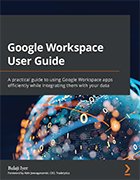Extend collaboration tools with 'Google Workspace User Guide'
Collaboration tools are key as businesses shift to hybrid work. Google Workspace supports productivity with Google Classroom, Marketplace apps and Google Assistant.
In an effort to remain more structured with daily tasks, organizations have sought to build a service that facilitates productivity in the workplace. Google Workspace includes multiple collaboration apps, such as Gmail, Calendar, Chat, Meet and Drive, to enable users to create an organized space and work more productively.
The productivity suite ensures users are able to collaborate and communicate effectively across the platform, as well as take advantage of the tools provided in order to work efficiently from any location. With a continuously changing hybrid working world, businesses are looking for ways to be more inclusive and adapt to different work settings.
The book, Google Workspace User Guide: A practical guide to using Google Workspace apps efficiently while integrating them with your data by Balaji Iyer, published by Packt Publishing, provides readers a technical understanding of what Google Workspace does, how to use it and its different features. Iyer provides specific use cases to illustrate how Google Workspace has created an inclusive environment beyond its basic features, making it easier for users to work with each other in real time.
Essentially, the author explains ways that Google Workspace is inclusive of all use cases -- such as through third-party clients -- no matter how someone uses the service. In an excerpt from Chapter 5, "Beyond Workspace," Iyer wrote about what goes into the service past the primary collaboration uses. He explains how Workspace can be integrated for educational purposes through Google Classroom, add-ons with Google Marketplace apps and Google Assistant.
Read Google Workspace User Guide: A practical guide to using Google Workspace apps efficiently while integrating them with your data
Click here to read Chapter 5, "Beyond Workspace."
Google Classroom, for example, uses Workspace's core services, which enhance the communication and collaboration between teacher and student. Marketplace apps support Google Workspace to solve workflows in ways the core services are not yet capable of addressing.
Additionally, employees can use Google Assistant as a resource to guide them throughout their workday. For example, users can ask Google Assistant-compatible devices questions, such as when they have a meeting, to start or create a meeting or if they have an upcoming deadline. All these functions improve UX and, ultimately, support a more productive and organized work environment.

 Click here to learn more about
Click here to learn more about 





